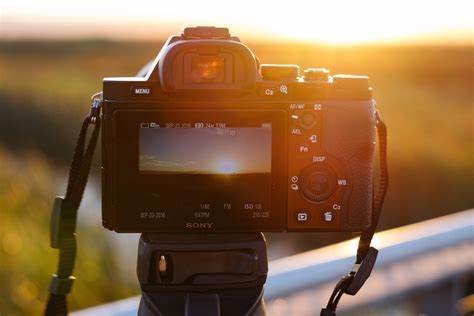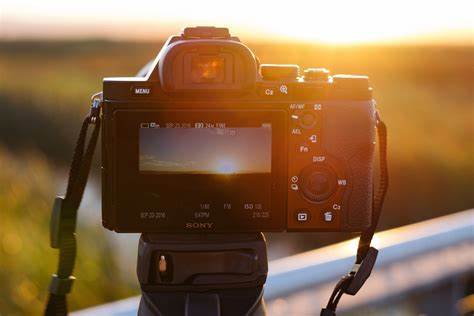

These 5 elements of photography can be used in art photography, film photography, and various other creative disciplines but we are gonna be looking at it through the lens of film making and photography. These elements are all there to help us think about how we can create an even more amazing image that draws our audiences into the image or film and also allows the audience to get clarification or to create some visually stunning pieces. But first let’s define what exactly the word photography means. The word photography has two parts photo and graphy , The prefix photo refers to light like in the word photon, the suffix graphy is referring to something written or drawn such as stenography or calligraphy so when we put these two together photo meaning light and graphy being something written or drawn we get photography.
The art of painting with light. Now when we say painting with light we don’t necessarily mean something like this but rather we’re talking specifically about how the light comes through the lens of a camera and is captured, thus creating a piece of art.
In this blog you’re gonna learn how you can level up your photography just by simply understanding the 5 elements of photography. The 5 elements you’re gonna learn about are texture, color, tone, line and space. Having a basic understanding of all 5 of these elements is really gonna help your photography to that next level. Now do you need to have all of these elements in every single photo that you take? No! But the more you’re able to incorporate effectively the better your photography will be. Now let’s go into a little greater detail about each of these elements.

TEXTURE
Now we all know what texture refers to when we’re talking about the real world if you look at something, you know exactly what it feels like. If you look at a table we know that it’s smooth, the texture of this table is smooth texture. We can see what the texture is of certain objects but this is something that doesn’t only apply to real life. This also applies to photography, with photography we can see exactly how something might feel. Texture is the quality of the surface of an object that you are recording. It can take your photos from really boring and dull and add a whole other visceral element to it because you’re focusing on the intricacies of the object. If you focus on the texture of something within that landscape, you can add a whole lot of dimension to your photo and completely create a new and interesting composition.
This is also why I’m talking about the texture after referring to form it’s much harder to see the texture of something if it looks two-dimensional but when you have something that has form it’s easier to show off what the texture of that subject is and one good thing about texture even though it is sometimes hard to capture in your photos most editing softwares will actually allow you to enhance certain texture within your photo when you’re able to effectively enhance your texture your pictures are going to look a lot better but be careful because with a lot of editing you can go overboard with the texture and then eventually that’s just gonna take away from the realism of the photo.
COLOUR
Color is one of the most important visual elements in photography, film making, design, art and so many other disciplines because of the impact it has on an audience. It can draw the audience’s attention to the subject matter or can have the exact opposite effect completely ruining the intention of photo. It can make an image feel cohesive and peaceful or have the opposite effect that make us feel weird and disgusted depending on the intention of the creative and that is why it’s important to understand color, that’s why we have created a color wheel and various color schemes that helps us as artists, designers and other disciplines to create a piecing images. Now how you use color in your photography is really going to be up to you Color really helps your audience differentiate between different objects in your photo. If everything you’re looking at now was the exact same color you wouldn’t be able to see anything. When it comes to your photography you can use color to your advantage by helping your subjects pop.
Say you have a background that is completely black and then any other pop of color that you see any bright colors that you see is only going to help that subject stand out much more than it would in a background that was not completely blacked out. Colors can also be effective in your pictures because they can help set the mood of your photo. Warmer colors like the reds and oranges and yellows those tend to be much more lively and vibrant just creating a more energetic mood for your photos. Cooler colors like blues like the greens those colors are really going to help create more of a sense of calmness in your photos and don’t think that every time you’re taking your pictures it has to be in color black and white also falls into this color category. So when it comes to color always keep in mind how they’re going to work with what you’re trying to photograph.
TONE
Tone refers to the level of brightness inside your image that means we’re looking at the brightest point of your image all the way to the darkest point and seeing how the light transitions from that bright point all the way to the dark. Now it’s super important because tone is crucial in creating a mood because lighting is the biggest tool for creating mood because by taking away light we can make it seem really dark and mysterious but by adding light we can make it seem bright and happy and all that good stuff and playing with our transitional levels you know you start getting all that mood getting it all romantic and stuff. So you know, understand your tone so you create that mood for your photo.
LINE
We all know lines, they’re literally everywhere around us, we see straight lines all the time but in photography lines can refer to almost any kind of line. Leading line is any object within your frame that causes a natural line and draws your audience’s attention to the subject of the photo or video. You have straight lines you have lines that go side to side, you have lines that go up and down, you have lines that are diagonal, you have lines that are curved, you have lines that are jagged, you have lines that swirl around everywhere. Lines are just going to be everywhere that you look.
If you’re a beginner photographer you’re not really going to be paying attention much to lines, simply because that’s just not something you’re going to be on the lookout for right away. Seeing lines outside of the subject that you’re just trying to focus on does take a little bit of time to recognize but once you see how lines really work with photography you’re going to have a deeper understanding of why lines are extremely important in the photos that you take. If you think of everything that you see in a photograph it starts with a line essentially without line the other elements just wouldn’t exist. So remember lines are the start of everything that you’re going to see in your photos and every line that you do see is going to represent something and put something out there in your photography.
SPACE
Now our fifth and final element that we’re going to talk about is space. No I’m not going to talk about the stars in the galaxy and the universe, that’s not what I mean by space, what I’m referring to when it comes to photography. It is the actual distance between objects and your photos, using space effectively can really change the perspective of a certain photo. You might sometimes hear people say shoot through objects have something off in the background, create that bokeh that’s because that’s really gonna give a different perspective from just a regular shot.
Also when it comes to space you need to understand that there are two types of space that you can have in your photos. You have positive space and you have negative space.
POSITIVE SPACE- The positive space is the space that’s taken up by your subjects.
NEGATIVE SPACE- The negative space is everything else surrounding your subject and don’t think that with negative space that space has to be playing with negative space, It can be filled with objects it doesn’t have to be completely blank. So when it comes to these elements of photography using all of them or as many as you can for every photo that you take is really going to help every photo that you take come together in a way that you it may not come together before.
So when you have a basic understanding of these elements it’s very easy to take your photography to that next level and I know this is photography It should be just as easy as pushing a button right well that’s not just how it works that’s not how photography works if it were that easy everyone would be a good photographer but it’s not and we all know some bad photographers out there so if you keep in mind some of this basic understanding of these elements, The next time you go out and shoot you’re going to come back with better pictures.